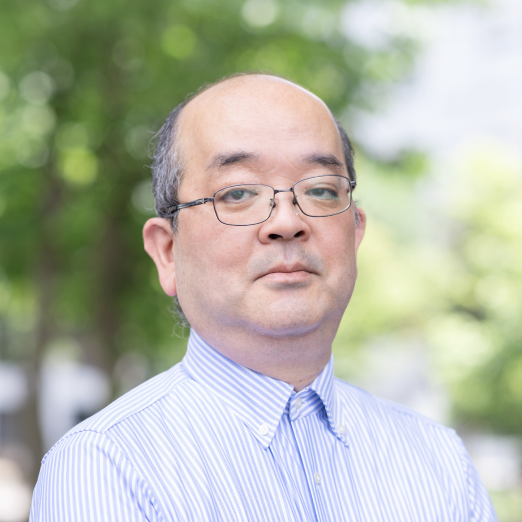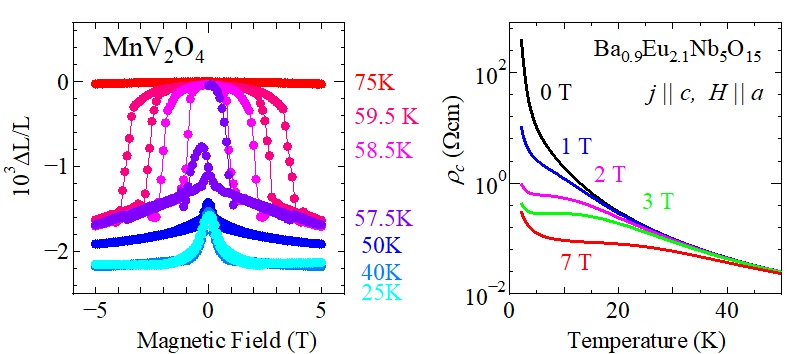
勝藤 拓郎 教授
Takuro Katsufuji
専門分野
複雑量子物性
新しい物質をつくり新しい物理を見出す
研究テーマ
遷移金属酸化物の物質開発 / 巨大外場応答を示す物質の開発、研究 / 光学測定による強相関電子系の研究
キーワード
クーロン相互作用, 軌道自由度
LINKS
RESEARCH OVERVIEW
研究概要
我々の身の回りにある物質のほとんどは「固体」と呼ばれるもので、ミクロに見ると、原子が順序よく整列しており、その間を電子が飛び回っています。一見簡単に見える舞台ですが、実はこれだけで驚くほど多様な性質が生み出されます。よく知られている例として、電気が流れたり(金属)、流れなかったり(絶縁体)、磁石についたり(強磁性)、もう少し高級な例としては、ノーベル賞の対象となった超伝導、量子ホール効果などは、すべて固体中の電子が生み出す性質です。固体中においては、一つの現象に対して数多くの電子が一度に寄与するために、このような多彩な性質が現れるのです。1つ1つの電子は波動方程式(シュレディンガー方程式)に従いますが、電子が多数集まったとき、そこは単純な方程式を超えた新しい物理の宝庫です。
私たちのグループは、新しい物質の開発、およびその材料における新しい物理現象の探索を目指しています。特に、電子が強く相互作用し集団的に振る舞う「強相関電子系」と呼ばれる遷移金属酸化物に焦点を当てています。この集団的な電子の振る舞いにより、これらの物質は外場に対して大きな応答を示したり、想像を超えた振舞を示したりします。例えば、一般的な材料に磁場をかけると磁化が発生しますが、これらの物質では電気抵抗率、誘電率、結晶構造、さらには色の変化が起こることがあります。これらの現象は基礎物理学的に興味深いだけでなく、将来の応用の可能性を秘めています。
図は、(左)磁場を印加すると結晶構造が変わるスピネル型MnV2O4 (右)磁場を印加すると電気抵抗率が大きく減少するTTB型Ba3-xEuxNb5O15です。

MESSAGE to STUDENTS
学生へのメッセージ
新しい物質を作る研究室です。新しい物質には新しい物理が隠れています。多数の電子がつくる新しい物理を一緒に発見しましょう。
学歴・経歴
‘ -1991年 東京大学 理学部 物理学科
1991年 – 1995年 東京大学 大学院理学系研究科 物理学専攻
1995年 – 1997年 東京大学 大学院工学系研究科 助手
1997年 – 1999年 ベル研究所 博士研究員
1999年 – 2002年 科学技術振興事業団 研究員
2002年 – 2007年 早稲田大学 理工学部物理学科 助教授
2008年 – 早稲田大学 理工学術院先進理工学部物理学科 教授
所属学協会
- 日本物理学会
- アメリカ物理学会

Takuro Katsufuji
Professor
Field of study
Quantum Physics of Complex Systems
New Physics through New Materials
Research Themes
Synthesis of new transition-metal oxides / Search for new materials that exhibit large response to an external field/Optical spectroscopy of strongly correlated electron systems /
Keywords
Coulomb interaction, Orbital degree of freedom
RESEARCH OVERVIEW
While the behavior of a single electron obeys the Schrodinger equation and is physically counterintuitive, the principle in question is quite simple. However, real-world objects consist of countless electrons, and the collective motion of such large numbers of electrons differs radically from the motion of a single electron. Each material acts as a “stage” for electrons which, in this analogy, may be regarded as “actors.” The actors (the electrons) behave in different ways in different materials (on different stages). The potentially novel behavior of electrons on novel stages presents an avenue for exploring the physics of new materials.
Our group is currently seeking to synthesize new materials, grow new crystals, and explore new physics in these materials. In particular, we focus on transition-metal oxides, in which electrons are strongly correlated and tend to act collectively (called “strongly-correlated electron systems”). Due to the collective behavior of correlated electrons, transition-metal oxides often exhibit a large response to external fields, sometimes generating surprising behavior. For example, applying a magnetic field to some common materials will result in magnetization. Applying a magnetic field to transition-metal oxides may lead to changes in electrical resistance, dielectric constants, crystal structures, and even color. In addition to their interest in terms of basic physics, such phenomena present the potential for future applications.
(Left) Crystal structure changes with applied magnetic field in spinel MnV2O4. (Right) Resistivity changes with applied magnetic field in Ba3-xEuxNb5O15 with tetragonal tungsten bronze (TTB) structure

MESSAGE to STUDENTS
We make new materials in our Lab. New materials hold hidden new physics. Let’s enjoy discovering the new physics created by many electrons.
Education and Career
‘- 1991 Department of Physics, University of Tokyo
1991 – 1995 Major in Physics, Graduate School of Science, University of Tokyo
1995 – 1997 Research Associate, Graduate School of Engineering, University of Tokyo
1997 – 1999 Postdoctoral Fellow, Bell Laboratories
1999 – 2002 Postdoctoral Fellow, JST
2002 – 2007 Associate Professor, Department of Physics, Waseda University
2008 – Professor, Department of Physics, Waseda University
Professional Memberships
- The Physical Society of Japan
- The American Physical Society
